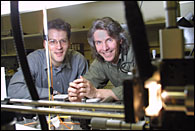Data at the speed of light
McGill is staking a claim in yet another high tech frontier.
David Plant, Andrew Kirk and Lawrence Chen are leaders in the area of photonics, the use of lightwave technology to move high amounts of data. Last August, the research trio announced an innovation in the field which may one day come to your desktop PC. They developed a computer microchip with both electrical and optical components.
 Electrical and computer engineering professors Andrew Kirk and David Plant
Electrical and computer engineering professors Andrew Kirk and David PlantPHOTO: Owen Egan |
|
"We demonstrated that conventional microelectronic computer chips can communicate with each other using light [optics] as well as with electronics," explains David Plant. The team's results were published in the Journal of Lightwave Technology.
The breakthrough makes optics for data transmission over short distances increasingly feasible.
"For many years, the optical fibre has been used for data transmission over long distances," says Plant. "But recently, the distance over which light has been used for data interconnections has shrunk, from tens or hundreds of kilometres to metres."
"Over very short distances, electrical signalling tends to be more efficient, and cheaper; over long distances, optical signalling is cheaper," notes Andrew Kirk. "What we are trying to do is push down the distance over which it is more efficient and better to use optics, until it is a short enough distance that it is practical to put them inside a computer."
The McGill team's chip shrinks that distance even further, Kirk says.
"The chip is designed for board-to-board communication, so you are communicating optically over a distance of a couple of inches, from one circuit board to another. For example, we can use optics to move data from memory chips to the processor. That provides more capacity than an electrical interconnection."
That is why the team believes that their chip can provide a leap in computer performance; it lends the data-transmission power of optical fibres to the much shorter distances that data must travel within a computer.
"Electronics are good for switching, processing and making decisions, so transistors are electronic," says Kirk. "Light is good for routing signals, and for transmitting data, which is why optical fibres are used for long distance communication."
Plant explains that the different components accomplish an efficient division of labour.
"We use the electrical connections for low speed control and set-up information, and the optical connections for high speed data transmission. The capacities are higher with the optics."
The most likely initial applications of this technology would be in computer labs and industries which need to process large quantities of data.
"This will be used for multi-processor computing systems, telecommunication systems -- any environment where you have a lot of information being passed around over small distances," says Plant.
"This would be ideal for computers used to analyze medical data, such as from an X-ray machine or CAT scanner," Kirk adds. "Other examples would be telephone switches, weather forecasting, medical and pharmaceutical labs, air traffic control. And it may reach the level of PCs, although that is a way off yet." Use in the average person's desktop would depend on costs coming down.
Two companies are working on marketing the McGill researchers' technology; one is Teraconnect, a spin-off from BAE Systems, a major corporate sponsor of their work, and the other is Xanoptix, which was formed by former BAE employees.
The McGill team is thus involved in an ongoing race for greater and greater computer capacity, to keep up with the increasingly heavy demands made on computers. According to Moore's Law, an often quoted predictor of computer capacity, the speed of transistors on an integrated circuit doubles every 18 months.
"Moore's Law has been in effect since the 1980s," Kirk notes. "Modern-day integrated circuits can have huge capacity, with hundreds of millions of transistors operating at speeds of gigabytes per second, but the performance of the interconnections [between circuits] has not gone up at the same rate. So processors can do a lot more processing, but they can't transmit the data as easily."
The result is that speedy processors are constantly slowed down by waiting for data to be transmitted to them.
"Imagine if you did not have a telephone, but had to communicate by mail; it would take you a long time to get anything done, no matter how smart you are," says Kirk.
"High-performance microprocessors spend a significant fraction of their time waiting for data to arrive," adds Plant. "That information bottleneck is due to the interconnect; the electrical connections between the processors are too slow. Our optical solution to this problem speeds up this communication; as a result, they can be more efficient in their computation, and produce answers more quickly."
The next stage is optical switching, which would have applications in telecommunications, says Kirk.
"Right now, we send a light from a transmitter to a receiver within a computer, but the same technology can be used inside optical fibre networks over long distances. Our next challenge will be technologies in which we can switch the light between different channels, in systems where we have many optical channels in parallel."
The researchers are also establishing a new Microfabrication Lab at McGill, in which they plan to develop nanotechnology applications of their work. The lab, sponsored by a Canada Foundation for Innovation grant, is the first of its kind at McGill and will be shared by researchers from science and engineering.
"One way technology is going to keep up with Moore's Law is by making components which are smaller and smaller," says Kirk. "We are interested in developing structures for controlling light which will be about 100 to 500 nanometres [in length]." A nanometre is one thousand millionth of a metre.
The team will be publishing their next research results in the Journal of Applied Optics in the spring.

